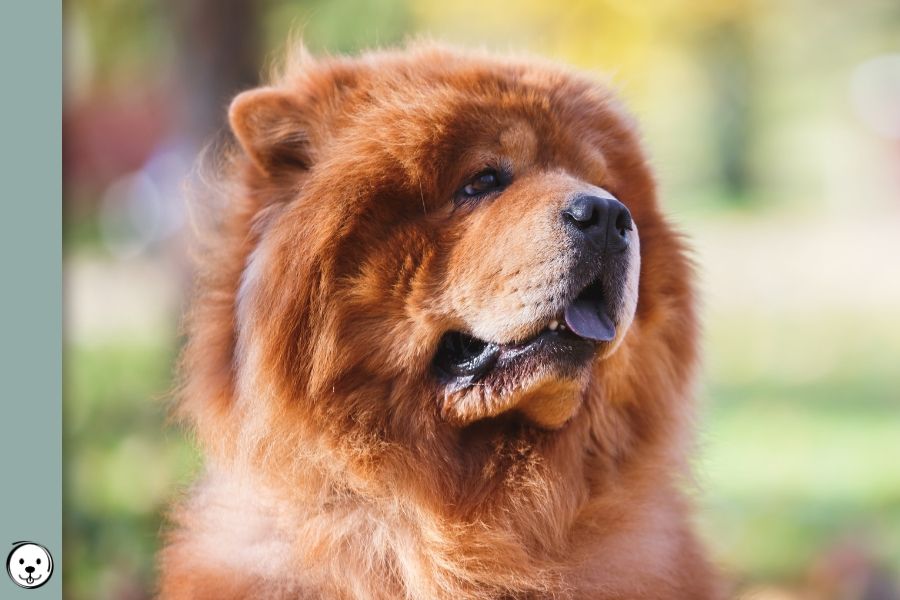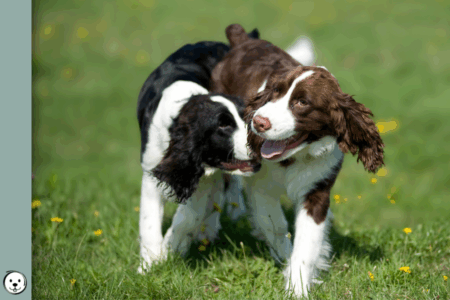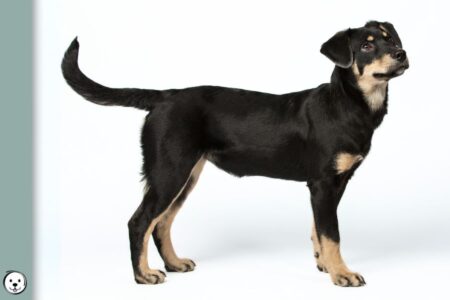The Chow Chow is an ancient dog breed from Northern China. These study spitz-type dogs are known for their very dense double coat Let’s learn about all the different Chow Chow coat colors.
Standard Chow Chow Coat Colors
Let’s have a closer look at the different Chow Chow color patterns:
“Clear colored, solid or solid with lighter shadings in the ruff, tail and featherings. There are five colors in the Chow: red (light golden to deep mahogany), black, blue, cinnamon (light fawn to deep cinnamon) and cream.”
AKC Breed Standard
“Whole coloured black, red, blue, fawn, cream or white, frequently shaded but not in patches or parti-coloured (underpart of tail and back of thighs frequently of a lighter colour).”
FCI Breed Standard
Red Chow Chow
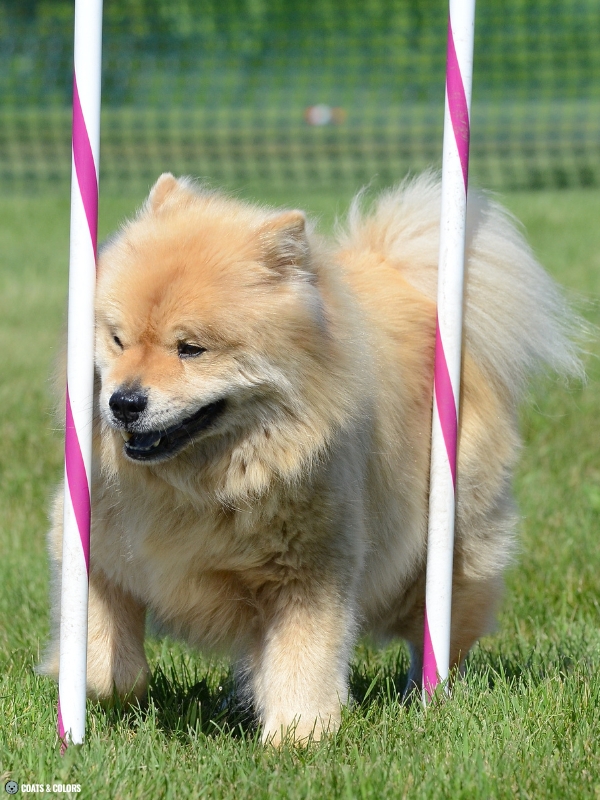


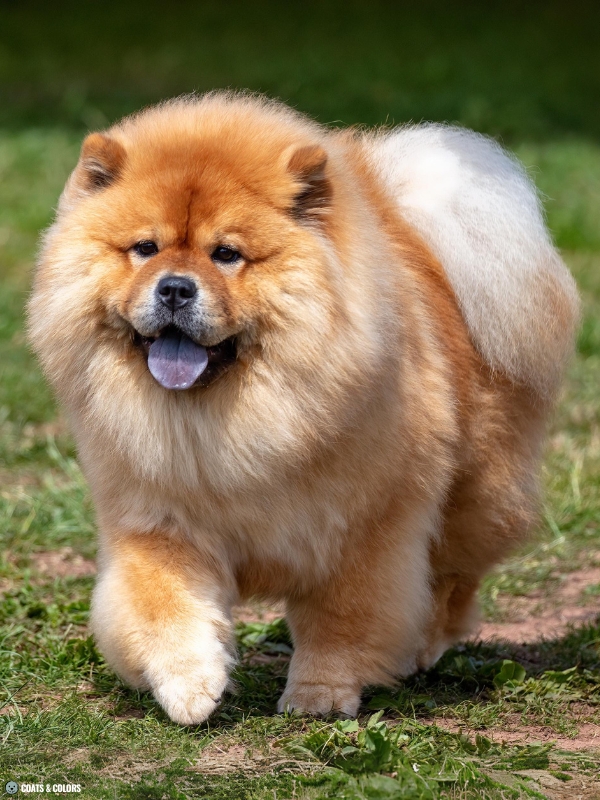

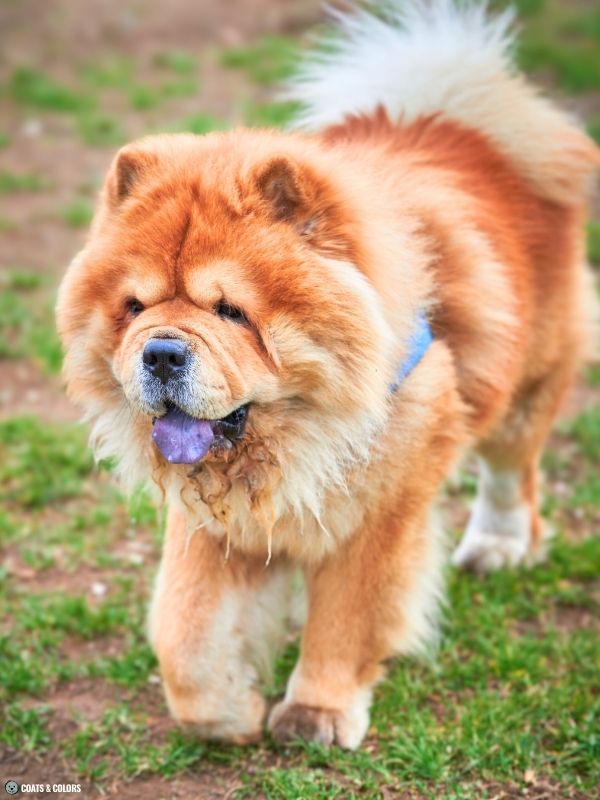
A red Chow Chow dog has a black-based (B/- D/-) sable pattern (E/- ky/ky Ay/Ay).
Their base color intensity falls in the range from “light golden to deep mahogany“. Most are orange-red to red, but there are also lighter more tan or golden Chow Chows.
And there are some really dark mahogany Chow Chows with very intense shades of red. But they are still red and not brown (only b/b dogs produce chocolate brown eumelanin, a sable dog shows a predominantly phaeomelanic coat, they shouldn’t be called light brown or dark brown or anything “brown”).
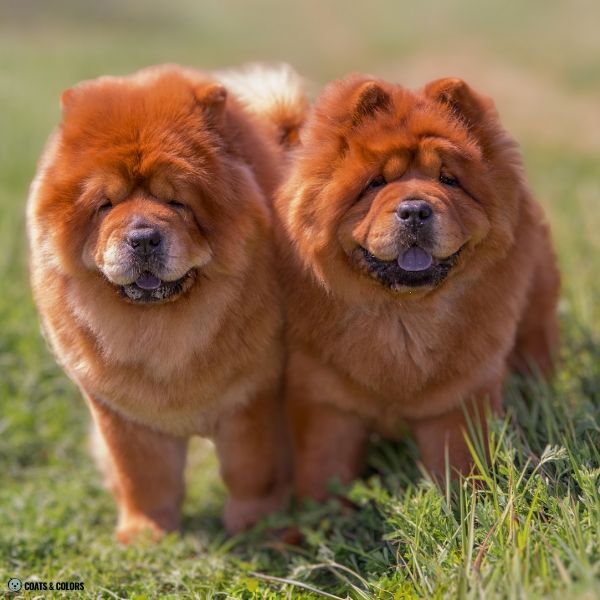
Most of these dogs have a clear sable pattern and lose their darker puppy shading. Only few red Chow Chows keep some amount of black sabling in their coat and may produce grayish undercoat.
Dogs with a fluffy undercoat tend to produce nearly white shadings on their ruff, breeches, or tail feathering. Additionally, ventral white or countershading is quite common in these dogs.
Red Chows with lighter shading are called “shaded red“.

Few red Chows have a black mask (Em/-). This is not related to puppy masking which is common in red Chow puppies and many other Asian spitz-type breeds but will eventually fade over time.
Masks and sable shading are only acceptable in puppies[7].
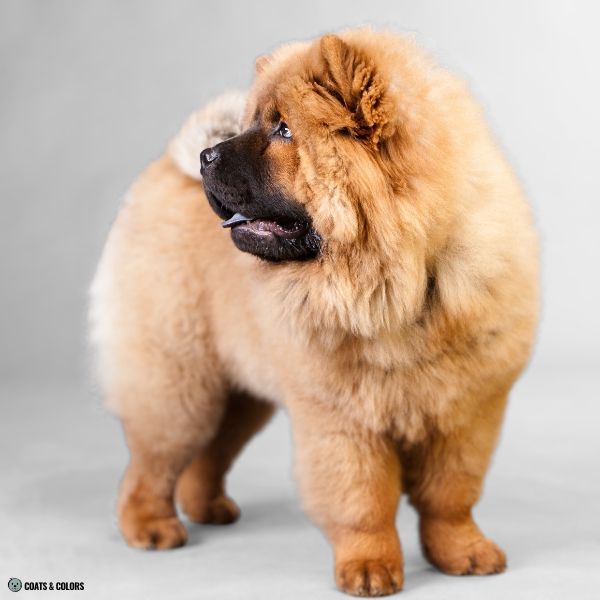
Cinnamon Chow Chow
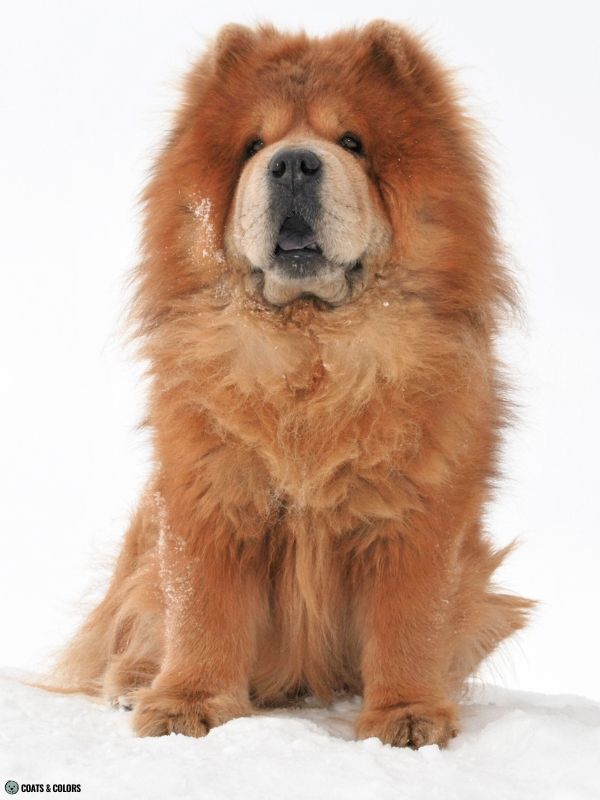
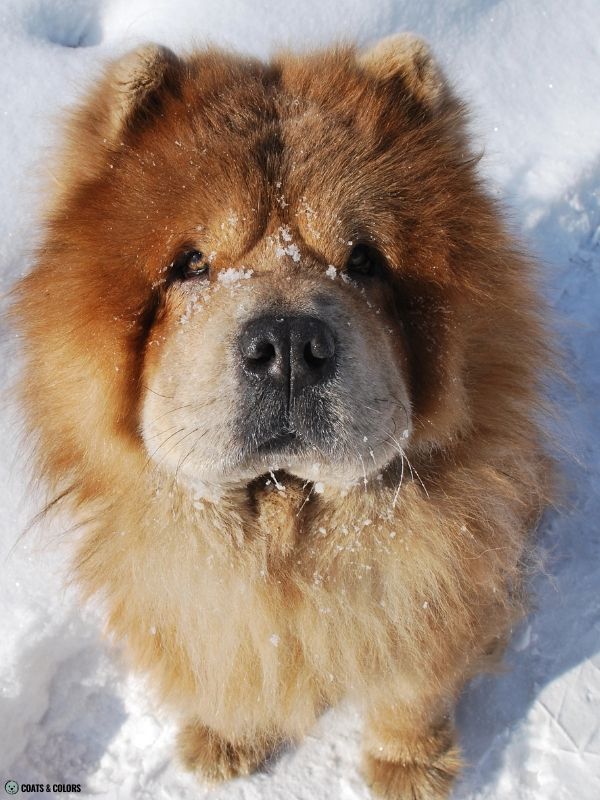

A fawn or cinnamon Chow Chow dog has a blue-based (B/- d/d) sable pattern (E/- ky/ky Ay/Ay).
The AKC Chow Chow “cinnamon color” is a breed term for dulled shades of red. It’s a synonym for the Chow Chow “fawn color” described in the FCI and Kennel Club standards.
Their base color intensity is described as “light fawn to deep cinnamon“.
Cinnamon can produce a light beige Chow Chow up to a darker shades that are thought to be “not quite red” and closer to the color of the spice of the same name.
Color dilution typically only affects eumelanin. However, cinnamon Chows look just slightly duller compared to normal reds. This is likely due to a super faint gray overlay caused by blue hair tips.
In many cases, reds and cinnamons can be very close in color.
Sable puppies are often born with lots of sabling which can give them an almost gray coat at first. But most Chow Chows lose their dark overlay and express a clear sable pattern. And just like reds, some blue sable puppies can show fading puppy masking. Just that their mask will be gray.
Like red Chows, cinnamons can also be either solid or have lighter and darker shades in their coat. This is because they also often have lighter feathering or countershading.
Black Chow Chow
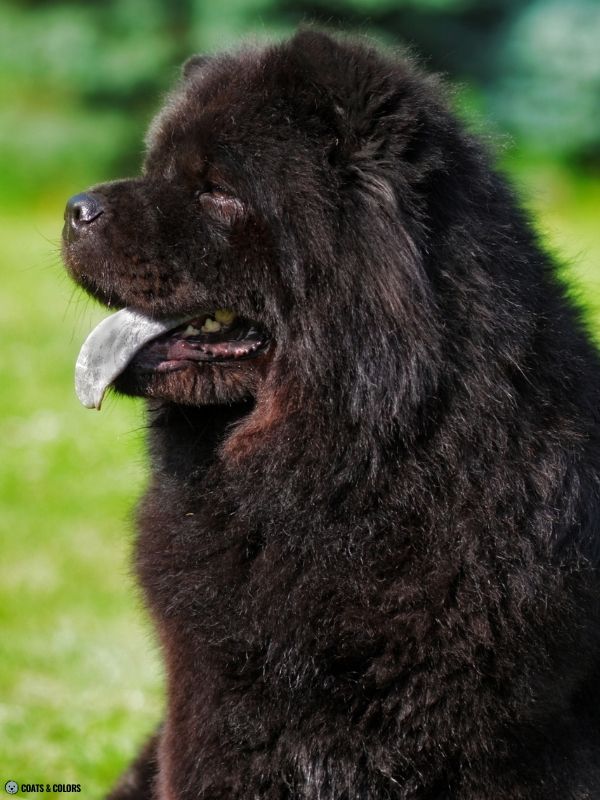
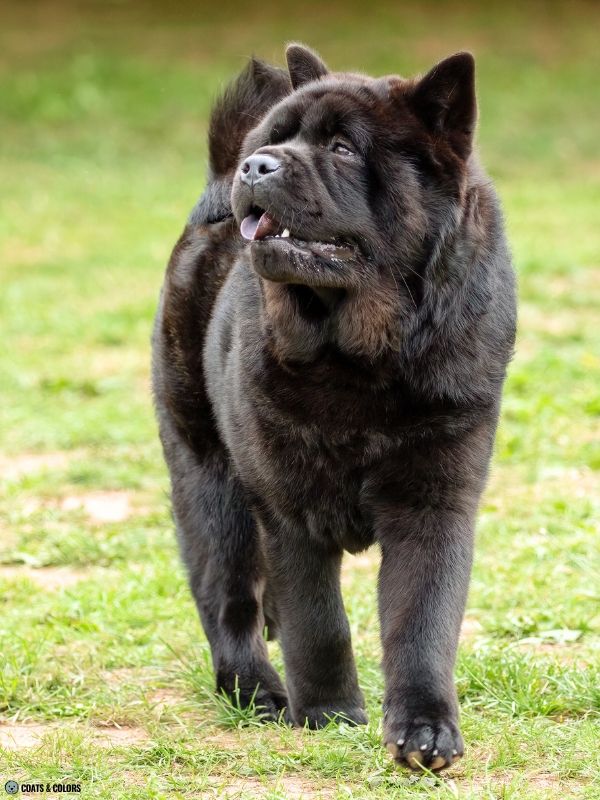
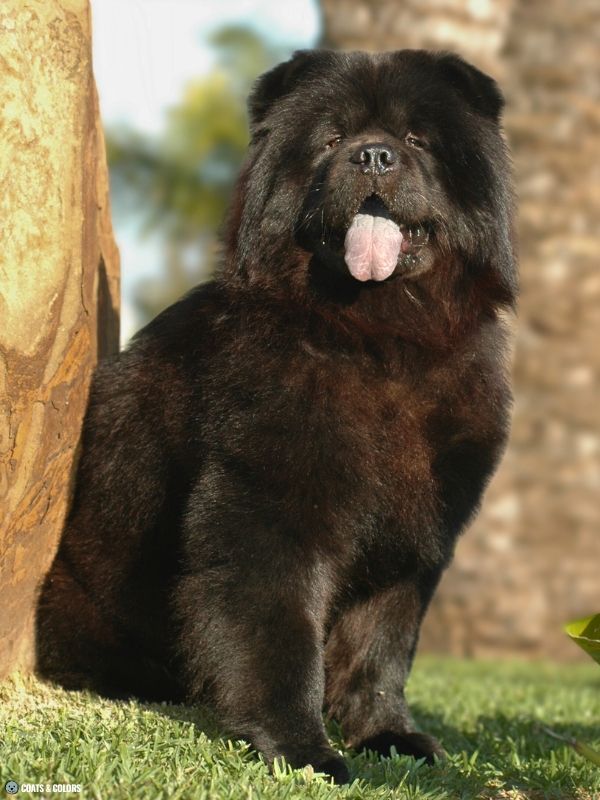
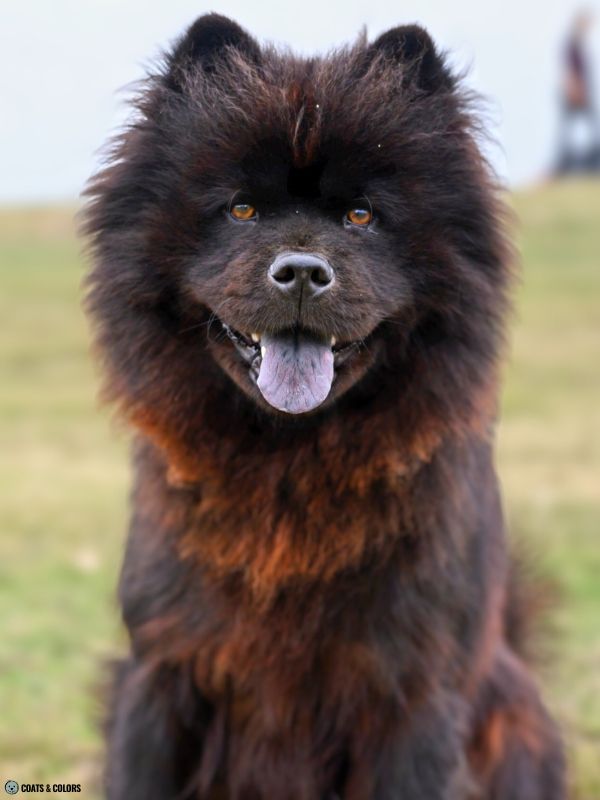
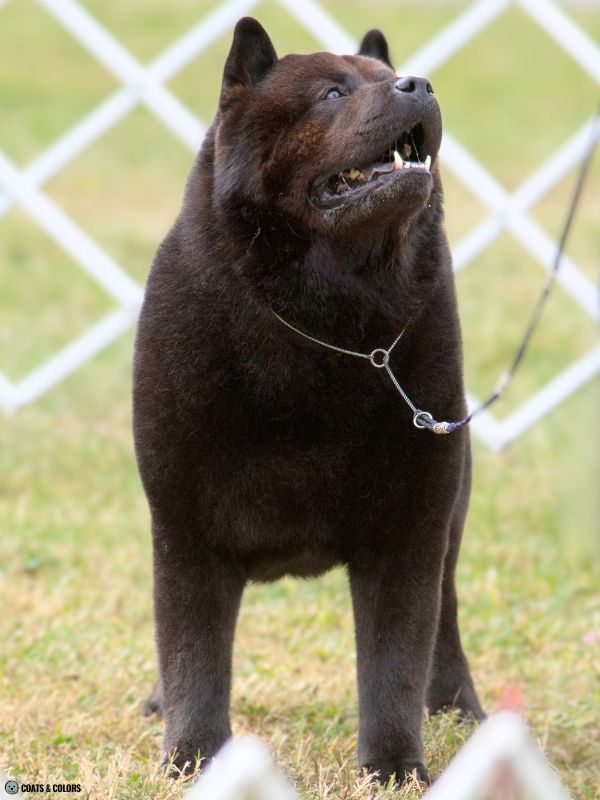

A black Chow Chow dog has a black-based (B/- D/-) dominant black pattern (E/- KB/-).
They do not always have a solid black coat. Some dogs show lots of silver shading in their tail, ruff or trousers. This might be due to pale undercoat or maybe some dogs being seal.
Sunbleaching and old coat can produce a very reddish cast, also called “rusting“.

Blue Chow Chow
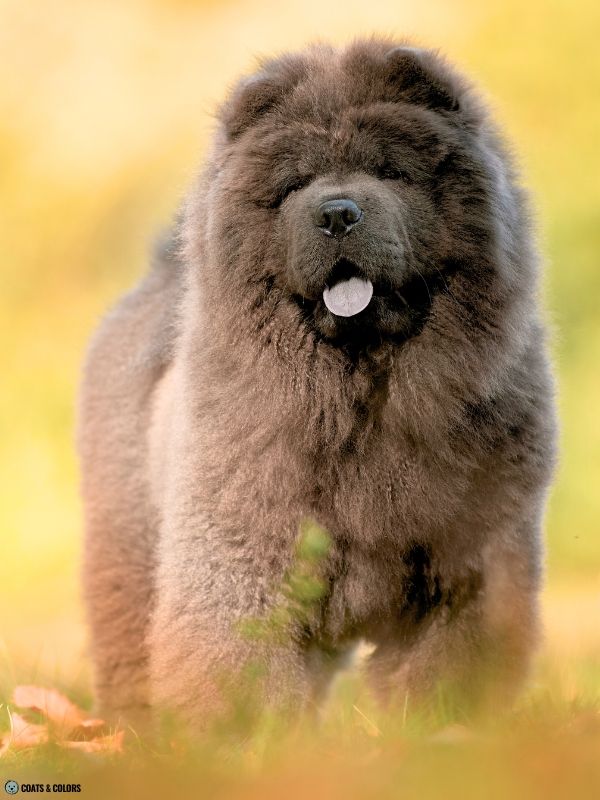

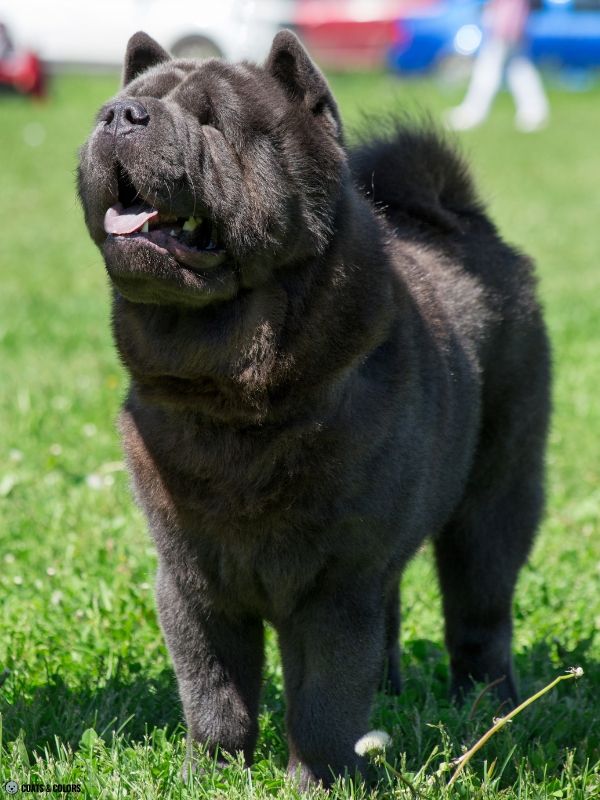
A gray Chow Chow dog has a blue-based (B/- d/d) dominant black pattern (E/- KB/-).
Some dogs are solid steel gray or lighter silvery gray, some may show paler feathering.
Lighter undercoat or seal can also cause a mixture of light and dark areas, giving them what Chow breeders may call a “frosted” look. Blue Chjow Chows can also “rust” to a more reddish color.
Cream Chow Chow
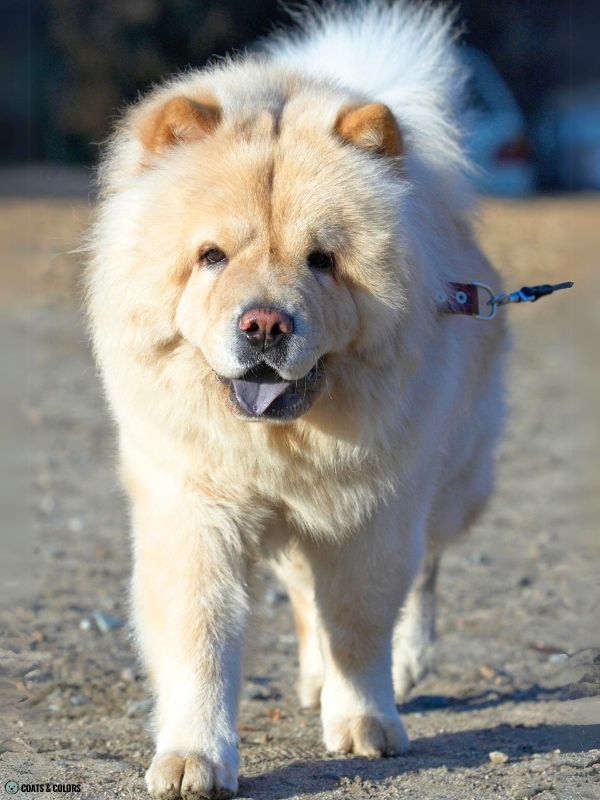
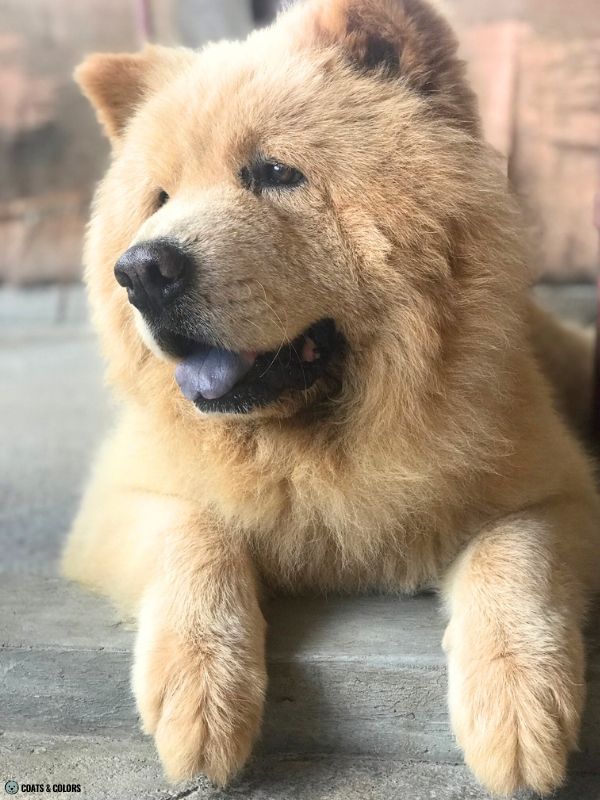
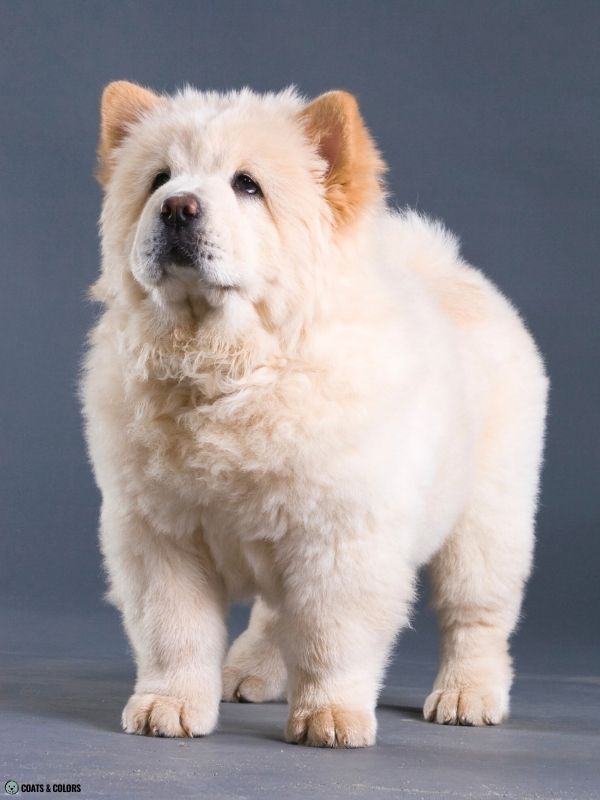



A cream Chow Chow dog has a recessive red pattern (e/e).
Their hair pigment cells can only produce phaeomelanin.
Chow Chows are one of the many breeds where recessive red dogs have been selected for very light phaeomelanin intensity, ranging from a light blonde to ivory white.
For some reason, this has caused their solid phaeomelanic sable dogs to be red while solid phaeomelanic e/e dogs have much lighter pigment.
But there is still some overlap in color with some sable dogs having very light pigment and some cream dogs having a moderate yellow or orange intensity.
However, cream dogs will never have a dark puppy mask and they will always have white whiskers. This sets them apart even from light-colored sable Chows.
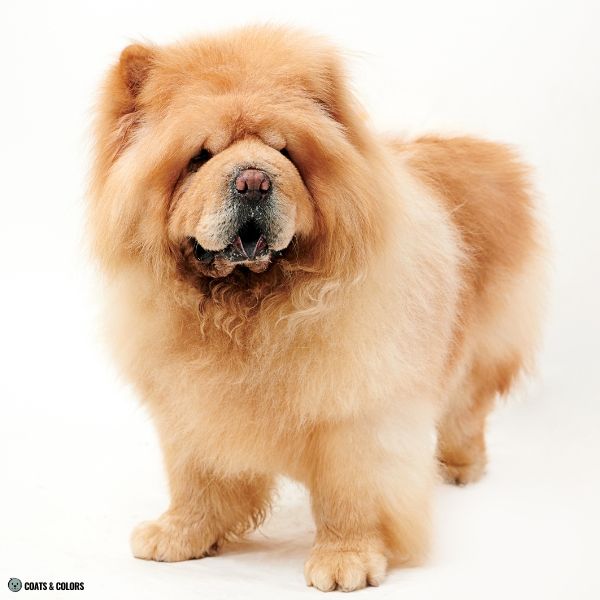
All white or cream Chows can have some darker yellow or orange shading on their face, ears, or back. By the way, only the FCI accepts all-white Chow Chows as a stand-alone variety.
The breed standard does not make a difference between black-based (B/- D/-) or blue-based (B/- d/d) cream. However, since all Chows are supposed to have brown eyes and black eye rims, there is likely some preference for black-based creams to not run into any problems and lose a show prospect.
Cream dogs often show strong nose fading turning their nose color to a pink or taupe color, often with the original pigment color only visible along the edges of the nose.
Non-Breed Standard Chow Chow Colors
Chow Chows are supposed to be solid in color only with some gradual shading throughout their coat. This excludes all “multi-colored” Chow Chow patterns (mask, brindle, merle, white, tan point).
Some non-standard colors happen due to recessive variants. Both parents need to be carriers to produce a puppy that got one copy from each parent and can actually express the recessive trait.
In Chow Chows, this applies to brown eumelanin (b/b) or a tan point pattern (at/at). Both traits are recessive to the normal Chow Chow variants and are not expressed in a B/b or Ay/at dog.
Some non-standard colors are achieved by crossbreeding to introduce a new trait on purpose.
In Chows, this applies to parti-colored dogs (sP), brindle (kbr) and obviously merle (M*).
What makes some colors “rare Chow Chow colors” is that you don’t see them in purebred dogs and not that they are hard to produce. Keep in mind, that color should be the least priority when choosing a puppy.
Black & Tan Chow Chows
The tan point variant (at) occurs in the Chow Chow breed but is very, very rare in purebred dogs[4].
It will be hidden in dominant black (E/- KB/-) or recessive red (e/e) dogs or dogs that also have a copy of the dominant sable variant at their A locus (E/- ky/ky Ay/at).
Only Chow Chows with an . This will turn a red (black sable) into a black & tan (black tan point) and a cinnamon (blue sable) into a blue & tan (blue tan point) pattern.
Paired with other non-standard traits, this can also be the basic pattern for a merle & tan dog or a brindle point pattern or give a tri-color Chow Chow which refers to tan point & white.
Brown Chow Chows
Chocolate-colored Chow Chows have brown eumelanin (b/b D/-).
This modifies the coat color on a solid black Chow Chow to solid chocolate brown. Dogs can be light brown to dark brown in color and often show lighter feathering on the tail and trousers.
It can also affect the other patterns and produce brown-based red or brown-based cream.
Lilac Chow Chows
Chow Chows with brown eumelanin (b/b) and color dilution (d/d) will produce lilac eumelanin.
Depending on their pattern, this can give lilac-based red, solid lilac, or lilac-based cream.
Brindle Chow Chows
Brindle (kbr/-) adds eumelanic stripes on top of a Chow Chow’s sable pattern.
Brindle striping can be sparse to heavy. All brindling will be black in red Chows and blue in cinnamon Chows (or stripes can be brown or lilac, depending on the B locus and D locus).
Brindle striping will not be expressed in cream dogs (e/e) since these dogs can not produce eumelanin.
Parti-Colored Chow Chows
Dogs with one or two copies of piebald spotting (sP) will express white markings. These markings happen due to a lack of pigment cells which will erase portions of any pattern.
This means dogs can be red & white, black & white, etc. White spotting may be less obvious in some cream Chow Chows due to the low contrast between off-white pigment and real white coat.
Merle Chow Chows
Merle was introduced into Chow Chows by crossbreeding.
Merle has the ability to remove random patches of eumelanin from a pattern. This creates areas with a weaker shade of eumelanin combined patches with the original color.
Merle needs at least some eumelanin to express in a dog’s pattern.
It will be hidden in all cream and in most clear sable patterns!
Red or fawn Chow Chows may show some faint merling as long as they have some dark puppy shading. But as soon as the sabling recedes the merle pattern will be gone.
Merle is most obvious in the solid coats of dominant black (KB) Chow Chows. Dogs with a melanistic mask (Em) may show a spotted merle mask. But brindle Merle may be hard to spot in fluffy coat.
Classic Merle (M) gives the marble pattern most of you will know. But different combinations of merle alleles can be anything from non-expressing or create a variety of marbling phenotypes. Stronger combinations can delete pigment to white which can ultimately lead to a double merle phenotype.
Merle can also give Chow Chow blue eyes (though this might also come from the dominant blue eye trait if one of the breeds used for crossbreeding were Australian Shepherd or Husky or their mixes).
Chow Chow Coat Colors Overview
The breed standard describes all the different traits a Chow Chow should have.
This includes his conformation and temperament but also the coat texture and color.
The major kennel clubs often use their own standards provided by their affiliated breed club. These standards are usually similar in their general outline but can differ in details like coat color.
Let’s see what different clubs have to say about the accepted Chow Chow coat color patterns[1-3]:
| AKC | FCI | KC | |
|---|---|---|---|
| Red | ✅ | ✅ | ✅ |
| Cinnamon = Fawn | ✅ | ✅ | ✅ |
| Black | ✅ | ✅ | ✅ |
| Blue | ✅ | ✅ | ✅ |
| Cream | ✅ | ✅ | ✅ |
| White | (-) | ✅ | ✅ |
Chow Chow Color Genetics
A dog’s coat gets its colors from two pigment types called eumelanin and phaeomelanin. Different proportions of colors in a particular dog’s coat create different patterns.
But Chow Chows, like most dog breeds, can only produce some of all the possible colors and patterns. These are the genes and alleles involved in Chow Chow standard coat colors and patterns:
| E-LOCUS | Em = melanistic mask E = normal pattern e = recessive red |
| K-LOCUS | KB = dominant black kbr = brindle ky = normal pattern |
| A-LOCUS | Ay = sable at = tan point |
| B-LOCUS | B = black b = brown |
| D-LOCUS | D = normal pigment d = diluted pigment |
| S-LOCUS | S = solid sP = parti spotting |
| M-LOCUS | m = non-merle M* = merle |
Eumelanin Colors
Purebred Chow Chows typically have black eumelanin (B/B).
Their pigment can be normal (D/-) or diluted (d/d) with diluted black being called blue.
Most breeds with diluted eumelanin have the d1 variant. However, cinnamon or blue Chows can also have a d2 variant (they can be d1/d1 or d1/d2 or d2/d2)[5].

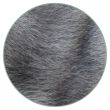
Only few purebred Chows have brown (b/b) or diluted brown aka lilac (b/b d/d) pigment[7].
Phaeomelanin Intensity
The phaeomelanin intensity in sable-patterned Chow Chows ranges from tan to red. With a sometimes slightly more matte gray-coated version of these colors in blue sable aka “cinnamon” dogs.
Dogs with a recessive red pattern were bred for a lighter cream or white intensity.

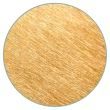
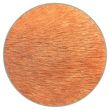
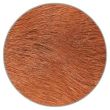
White Spotting
Chow Chows don’t come with white spotting.
But some residual white like a thin white patch on the chest or white toes can just happen in any dog.
Color Patterns
The accepted patterns in a dog breed describe the distribution of colors in a dog’s coat. Dogs can be solid-colored or have a pattern with more than one color.
Breed standards almost always use breed-specific and purely descriptive terms. It’s sometimes on us to translate breed standard terminology into more universal genetic terms.
But Chow Chow dog colors are pretty straightforward:
| Color Term | Genotype |
|---|---|
| Red black-based sable | B/- D/- E/- ky/ky Ay/Ay |
| Cinnamon blue-based sable | B/- d/d E/- ky/ky Ay/Ay |
| Black black-based dominant black | B/- D/- E/- KB/- Ay/Ay |
| Blue blue-based dominant black | B/- d/d E/- KB/- Ay/Ay |
| Cream & White recessive red | e/e |
Chow Chow Eye Colors
All Chow Chows are supposed to have dark brown eyes.
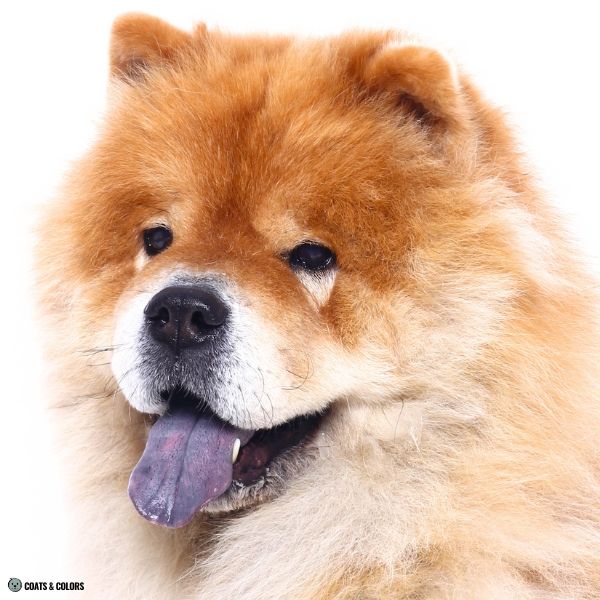
Eye color is a product of pigment color and pigment density.
With darker eumelanin colors and more densely packed pigment giving darker eye colors. This means that dogs with diluted black eumelanin are typically expected to have yellow or amber eyes.
And green-blue eyes are common in gray Chow Chow or cinnamon Chow Chow puppies.
“Dark, oval shaped, medium sized and clean. A matching coloured eye permissible in blues and fawns.“
FCI Breed Standard

Blue and cinnamon dogs can not change that their pigment is lighter, they have to compensate with more pigment to achieve an eye color that passes as “brown” as required by their standard.
Another problematic statement in the AKC breed standard, from a color genetics standpoint, is the demand for black eye rims in all Chow Chows. That’s just not possible for dogs with blue pigment and creates the artificial need to breed for a gray so dark that it passes as black.
“Eyes dark brown […] The eye rims black […]”
FCI Breed Standard
Chow Chow Nose Colors
The dog’s nose gets pigmented via eumelanin.
It will be black in black-based patterns and blue in blue-based patterns.
Red Chows and black Chows produce black eumelanin and have a black nose.
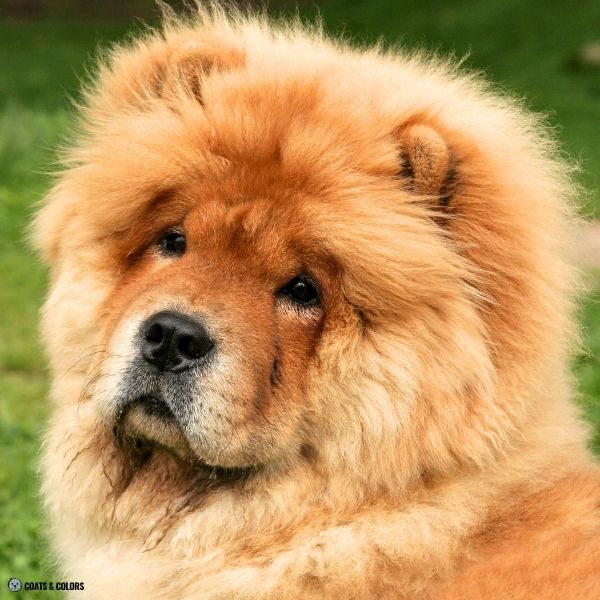
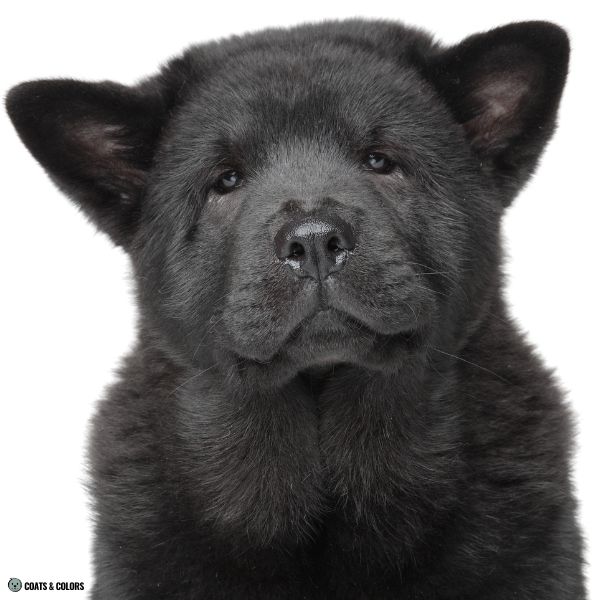
Cinnamon Chows and blue Chows produce blue eumlanin and have a slate gray nose.
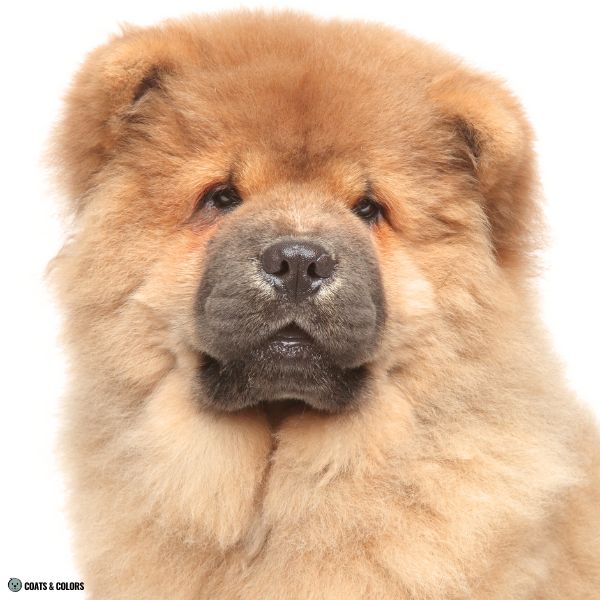

However, the AKC Chow Chow breed standard does not concern itself with the limitations of nose color genetics. They simply decided on something and stick with it, whether it makes sense or not.
Cinnamons have blue eumelanin, they can’t have a black nose! A “black-nosed cinnamon” is either a mislabeled red dog or it has a gray nose so dark that it passes for black.
“Reds, Blacks and Cinnamons must have a solid black nose. Blue Chows may have a solid blue or slate nose.”
AKC Breed Standard
“[…] in blues and fawns a self-coloured nose (but black preferable in all cases).”
FCI Breed Standard

Cream Chows often have strong nose color fading. This often turns their originally black or blue nose quite pinkish or can dilute the nose color so that we perceive it as brownish.
But B/B dogs do not produce brown pigment and there is no such thing as pink pigment.
“Cream Chows may have a range of nose color, from dark black/brown solid pigment, fading to pinkish pigment, with or without darker nose rim pigment at the outer edge.”
AKC Breed Standard
“[…] cream and near white, in which case a lighter coloured nose is permissible […]”
FCI Breed Standard
Chow Chow Tongue
One of the hallmark traits of purebred Chow Chows is their black tongue.
A trait they share with the Chinese Shar Pei.
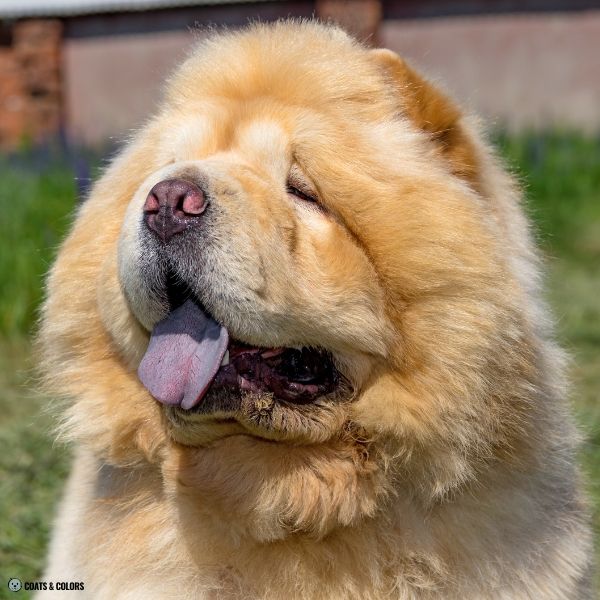
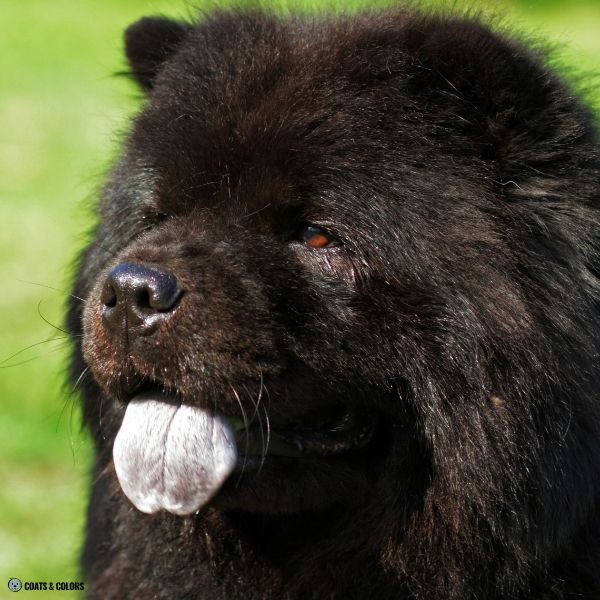

Chow Chow puppies can have pink tongues at birth which then eventually darkens to their characteristic dark color. That does not always work and some dogs keep small areas of visible pink color which is a major fault color-wise and disqualifies them from conformation events.
Pink gums are accepted but dark gums are preferred[8].
Again, dogs with color dilution will have to resort to blue tongue pigment. This can give them a slightly paler tongue compared to the more common red, black or black-based cream dogs.
“Edges of the lips black, tissues of the mouth mostly black, gums preferably black. A solid black mouth is ideal. The top surface and edges of the tongue a solid blue-black, the darker the better.”
AKC Chow Chow Breed Standard
The AKC standard ignores that diluted pigment will also affect tongue color. In comparison, the Shar Pei standard states that dilutes are allowed to have “solid lavender pigmentation“. So why not Chows?
Only the FCI standard accounts for the effect of diluted pigment on tongue color.
“A bluish-black tongue is characteristic. […]“
“A solid black mouth including the roof and flews, with a bluish black tongue is ideal. However, some dilution may be evident in the gums of blues and fawns and this dilution may be more pronounced in creams and whites.”
FCI Breed Standard
Chow Chow Coat Types
Most Chow Chows have a thick rough coat, but they also come with a short-coated variety:
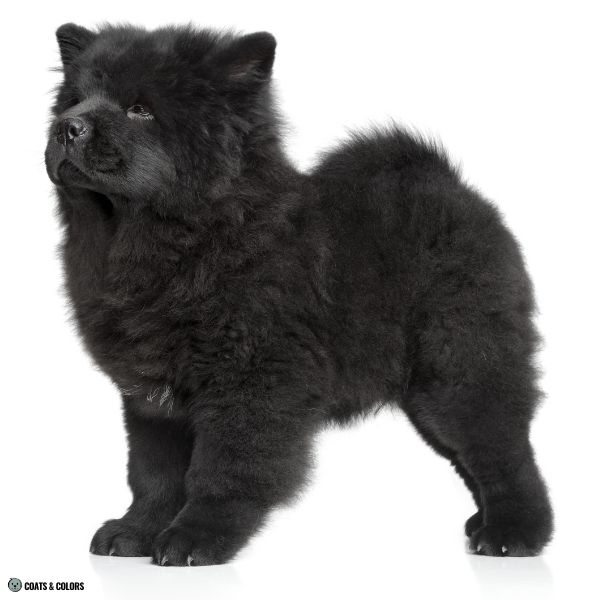
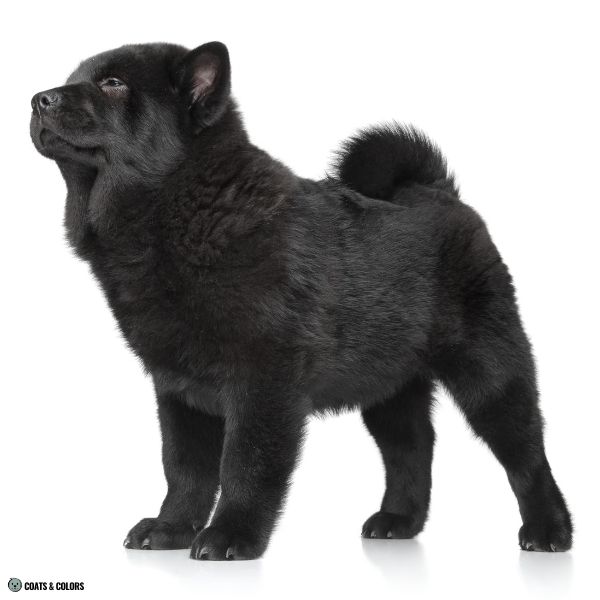
“In the rough coat, the outer coat is abundant, dense, straight and offstanding, rather coarse in texture; the undercoat soft, thick and wooly. […] The coat forms a profuse ruff around the head and neck, framing the head.”
“[…] smooth coated Chow, which has a hard, dense, smooth outer coat with a definite undercoat. There should be no obvious ruff or feathering on the legs or tail.“
AKC Breed Standard
“Rough: Profuse, abundant, dense, straight and stand-off but not excessive in length. Outer coat coarse, with soft woolly undercoat. Especially thick round neck forming a mane or ruff and with good culottes or breechings on back of thighs.”
“Smooth: Coat short, dense, straight, upstanding, not flat, plush-like in texture.”
FCI Breed Standard
Other Coat Types in Chow Chows
A very small number of Chow Chows has a curly variant[4].
This can result in a wavy coat or quite a bit of crimp and produce a non-standard coat type.
Learn More
Links
[1] American Kennel Club (AKC): Official Standard of the Chow Chow (pdf)
[2] Fédération Cynologique Internationale (FCI): Chow Chow Breed Standard (pdf)
[3] The Kennel Club (KC): Chow Chow Breed Standard
[4] Dreger et al. (2019). True Colors: Commercially-acquired morphological genotypes reveal hidden allele variation among dog breeds, informing both trait ancestry and breed potential. PLoS ONE 14(10): e0223995. https://doi.org/10.1371/journal.pone.0223995
[5] Bauer, Kehl, Jagannathan, Leeb: A novel MLPH variant in dogs with coat colour dilution. Anim Genet. 2018. http://dx.doi.org/10.1111/age.12632
[6] Yang et al. The origin of chow chows in the light of the East Asian breeds. BMC Genomics 18, 174 (2017). https://doi.org/10.1186/s12864-017-3525-9
[7] Dr. Gail Forsythe. Comparative AKC CKC FCI breed standard interpretation. 2023.
[8] Chow Chow Club Inc: Judges Education.

Hi! I’m Steffi. I am a biologist and a big time dog nerd. You are curious about coat color genetics? You’ve come to the right place! Read more.

